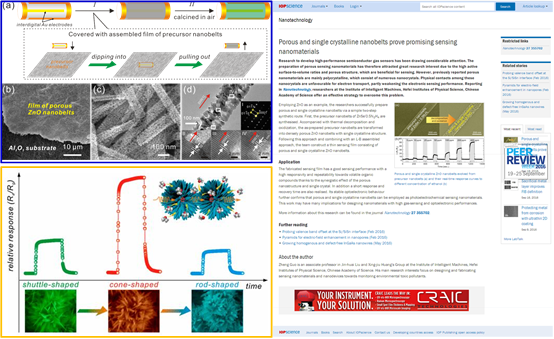Over the last several decades, nanomaterials with porous structures have been drawing considerable attention because of their fascinating characteristics. Especially for the fabrication of sensors, they have been widely employed as sensing units, which is derived from two main aspects. One is their higher active surface-to-volume ratios in contrast to solid nanomaterials, greatly enhancing their response; the other is that porous nanostructures are more favorable for the diffusion of detected gases, meaning that their response and recovery time can be expectedly improved.
Given this, a study team led by Prof. HUANG Xingjiu and Prof. LIU Jinhuai in Institute of Intelligent Machines, Hefei Institutes of Physical Science, achieves an important progress on nano-sensors with high sensitivity and high stability of gas-sensing performance. The study results were respective published in Nanotechnology (2016, 27, 355702) with title Porous and single-crystalline ZnO nanobelts: fabrication with annealing precursor nanobelts, and gas-sensing and optoelectronic performance, and ACS Sensors (DOI: 10.1021/acssensors.6b00597) with title Hierarchical Morphology-Dependent Gas-Sensing Performances of Three-Dimensional SnO2 Nanostructures.
In the first work (Nanotechnology), based on the sensitive materials of ZnO, combined with the method of calcination of precursor and L-B film self-assembly technology, porous and single crystalline nanobelts are designed. Because of the synergistic effect from their porous and single-crystalline nanostructures, they present good sensing performance with high response and repeatability toward volatile organic compounds (VOCs). Promisingly, the porous ZnO nanobelts with a single-crystalline structure can be expected as novel sensing materials for fabricating electronic nanodevices. It is worth mentioning that the research ( Nanotechnology, 2016, 27, 355702. ) has been reported by Nanotechweb.Org website Labtalk News bar with title " Porous and single crystalline nanobelts prove promising sensing nanomaterials ".
In the second work (ACS Sensors), researchers also design the synthesis of three-dimensional hierarchical SnO2 nanostructures. Via controlling the evolution of their hierarchical nanostructures, the researchers find that their sensing behaviors are greatly related with their hierarchical morphologies. The result analysis indicates that their good sensing performance is mainly attributed to the formation of more active surface defects and mismatches during the process of thermal recrystallization. Among the achieved hierarchical morphologies, three-dimensional cone-shaped hierarchical SnO2 nanostructures display the highest relative response up to about 175 toward 100 ppm of acetone as an example. Furthermore, they also exhibit good sensing responses toward other typical VOCs. Evidently, it exhibits good stability and the response rate only declines about 15% after four months.
Most importantly, the above-mentioned works can be potentially extended to fabricate electronic nanodevices and other three-dimensional metal oxide hierarchical nanostructures with good gas-sensing and catalytic performance.
These two works were supported by the National Key Scientific Program-Nanoscience and Nanotechnology, the National Natural Science Foundation of China.

The diagram of porous and single-crystalline ZnO nanobelts gas-sensing sensors fabrication and structure characterization (top left). Labtalk News reports (right). The evolution of three-dimensional hierarchical SnO2 nanostructures and its gas-sensing performance(lower left).
(Imaged by GUO Zheng)
Article 1 click: http://iopscience.iop.org/article/10.1088/0957-4484/27/35/355702
Labtalk News: http://iopscience.iop.org/journal/0957-4484/labtalk/article/66287
Article 2 click: http://pubs.acs.org/doi/abs/10.1021/acssensors.6b00597
Title1: Porous and single-crystalline ZnO nanobelts: fabrication with annealing precursor nanobelts, and gas-sensing and optoelectronic performance
Title2: Hierarchical Morphology-Dependent Gas-Sensing Performances of Three-Dimensional SnO2 Nanostructures
Keywords: ZnO; porous nanobelts; gas-sensing, single-crystalline; volatile organic compounds; SnO2; hierarchical nanostructure; surface defects and mismatche
Contact:
Prof. HUANG Xing-Jiu, Ph. D
Institute of Intelligent Machines, Chinese Academy of Sciences, Hefei 230031, China
(http://www.iim.cas.cn)
Tel: 86-551-6559-1167
Email: xingjiuhuang@iim.ac.cn
